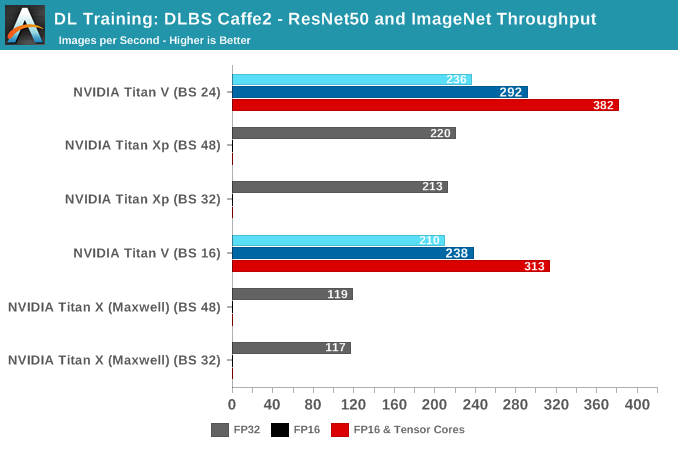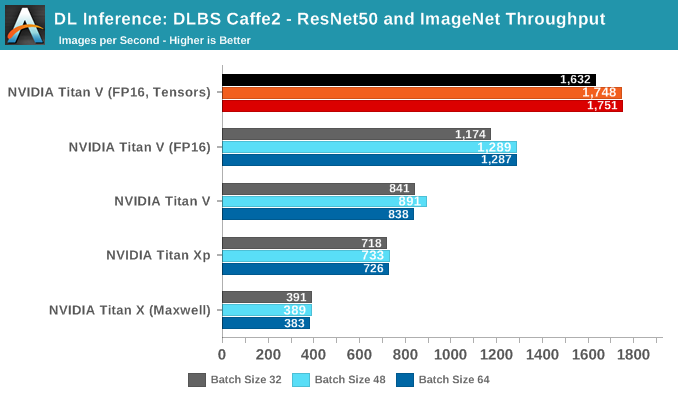The NVIDIA Titan V Deep Learning Deep Dive: It's All About The Tensor Cores
by Nate Oh on July 3, 2018 10:15 AM ESTHPE DLBS, Caffe2: ResNet50 and ImageNet
On that relevant note, we'll take a look at HPE Deep Learning Benchmark Suite, part of their Deep Learning Cookbook. With a different angle than usual DL benchmark suites, its wide-ranging test-running modularity lends itself to quickly diagnose issues or bottlenecks on hardware platforms, which would be useful for an organization like HPE. Focused mostly on NVIDIA GPUs running computer vision CNNs, the DLBS setup is Volta-aware and is essentially outputs throughput and time metrics only, with some advanced monitoring and visualization tools that are only somewhat user-friendly.
For our purposes, it allows us to corroborate the NVIDIA Caffe2 Docker benchmark, so we train and inference with a ResNet50 model on ImageNet. But as the models and implementations are different, these throughput numbers shouldn't be directly compared to NVIDIA's Caffe2 Docker test.

During the training benchmarking, certain batch sizes for Titan V refused to run, but generally, we see the same trend as before, with FP16 and tensor cores providing higher throughput.
We see the same trends continue with inferencing. Unfortunately, the DLBS Caffe2 test does not seem to support INT8 inferencing.











65 Comments
View All Comments
krazyfrog - Saturday, July 7, 2018 - link
I don't think so.https://www.anandtech.com/show/12170/nvidia-titan-...
mode_13h - Saturday, July 7, 2018 - link
Yeah, I mean why else do you think they built the DGX Station?https://www.nvidia.com/en-us/data-center/dgx-stati...
They claim "AI", but I'm sure it was just an excuse they told their investors.
keg504 - Tuesday, July 3, 2018 - link
"With Volta, there has little detail of anything other than GV100 exists..." (First page)What is this sentence supposed to be saying?
Nate Oh - Tuesday, July 3, 2018 - link
Apologies, was a brain fart :)I've reworked the sentence, but the gist is: GV100 is the only Volta silicon that we know of (outside of an upcoming Drive iGPU)
junky77 - Tuesday, July 3, 2018 - link
ThanksAny thoughts about Google TPUv2 in comparison?
mode_13h - Tuesday, July 3, 2018 - link
TPUv2 is only 45 TFLOPS/chip. They initially grabbed a lot of attention with a 180 TFLOPS figure, but that turned out to be per-board.I'm not sure if they said how many TFLOPS/w.
SirPerro - Thursday, July 5, 2018 - link
TPUv3 was announced in May with 8x the performance of TPUv2 for a total of a 1 PF per podtuxRoller - Tuesday, July 3, 2018 - link
Since utilization is, apparently, an issue with these workloads, I'm interested in seeing how radically different architectures, such as tpu2+ and the just announced ibm ai accelerator (https://spectrum.ieee.org/tech-talk/semiconductors... which looks like a monster.MDD1963 - Wednesday, July 4, 2018 - link
4 ordinary people will buy this....by mistake, thinking it is a gamer. :)philehidiot - Wednesday, July 4, 2018 - link
"With DL researchers and academics successfully using CUDA to train neural network models faster, it was only a matter of time before NVIDIA released their cuDNN library of optimized deep learning primitives, of which there was ample precedent with the HPC-focused BLAS (Basic Linear Algebra Subroutines) and corresponding cuBLAS. So cuDNN abstracted away the need for researchers to create and optimize CUDA code for DL performance. As for AMD’s equivalent to cuDNN, MIOpen was only released last year under the ROCm umbrella, though currently is only publicly enabled in Caffe."Whatever drugs you're on that allow this to make any sense, I need some. Being a layman, I was hoping maybe 1/5th of this might make sense. I'm going back to the porn. </headache>